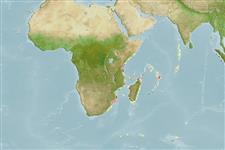>
Scombriformes (Mackerels) >
Ariommatidae (Ariommatids)
Etymology: Ariomma: Greek, ari = very, strength, superiority + Greek, omma = eyes (Ref. 45335).
Environment: milieu / climate zone / depth range / distribution range
Οικολογία
Θαλασσινό(ά) βαθύβιο(ς); εύρος βάθους 205 - 250 m (Ref. 28158). Deep-water
Western Indian Ocean: Saya de Malha and Tanzania.
Μέγεθος / Βάρος / Age
Maturity: Lm ? range ? - ? cm
Max length : 18.8 cm SL αρσενικό/απροσδιόριστο; (Ref. 28158)
Caught mainly by bottom trawl (Ref. 28158).
Life cycle and mating behavior
Maturities | Αναπαραγωγή | Spawnings | Egg(s) | Fecundities | Προνύμφες
Oviparous, gonochorous, with pelagic eggs (Ref. 101194).
Piotrovsky, A.S., 1987. New stromateoid species (Centrolophidae, Ariommidae) from the western tropical Indian Ocean. Vopr. Ikhtiol. 27 (3):506-509. (Ref. 28158)
IUCN Red List Status (Ref. 130435)
Threat to humans
Harmless
Human uses
Εργαλεία
Special reports
Download XML
Διαδικτυακές πηγές
Estimates based on models
Preferred temperature (Ref.
123201): 12.1 - 15.2, mean 12.7 °C (based on 4 cells).
Phylogenetic diversity index (Ref.
82804): PD
50 = 0.5156 [Uniqueness, from 0.5 = low to 2.0 = high].
Bayesian length-weight: a=0.01413 (0.00591 - 0.03375), b=2.95 (2.74 - 3.16), in cm total length, based on LWR estimates for this (Sub)family-body shape (Ref.
93245).
Τροφικό Επίπεδο (Ref.
69278): 3.5 ±0.5 se; based on size and trophs of closest relatives
Ελαστικότητα (Ref.
120179): Μεσαίο(α), ελάχιστος χρόνος για διπλασιασμό πληθυσμού 1,4 - 4,4 έτη (Assuming tmax>3).
Fishing Vulnerability (Ref.
59153): Low vulnerability (13 of 100).
